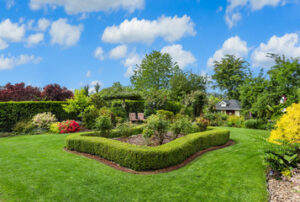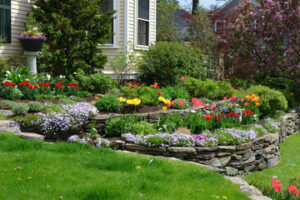Kentucky Landscaping is the process of creating outdoor spaces where people can entertain, lounge and relax. It also offers environmental benefits, such as reducing erosion and improving air quality.

Unity is achieved when a landscape’s elements appear to belong together. This is accomplished by using repeating forms and structures, and creating strong observable lines that guide the eye.
Landscape aesthetics are the characteristics that make an outdoor space pleasant to look at. They include a combination of factors, such as color, form, and texture, and can be used to create unified designs. These design elements are often used to evoke specific emotions in the viewer. For example, cooler colors can represent calmness and tranquility, while warmer colors like red and yellow convey warmth and friendliness. They are also important for creating a sense of place.
Landscaping is a great way to add value to your property, as well as make it more enjoyable for you and your family. While many people believe that landscaping is a costly endeavor, it can actually be quite affordable if you choose the right materials and plan your design carefully. A good starting point is to look at your home and decide what style of landscaping will best suit its architectural features. After that, consider the different plants and hardscaping materials available in your area, and compare prices to find the best deals.
In terms of aesthetics, landscaping is a highly personal choice that can be affected by cultural and environmental values. In general, people prefer to spend time in attractive outdoor settings. This enjoyment can lead to psychological and emotional benefits, including improved mood and lower stress levels. Moreover, landscapes can help in the preservation of natural and cultural heritage, which is a vital part of sustainable development.
There are two main approaches to the field of landscape aesthetics: objective and subjective. The former relies on the judgment of experts, while the latter is based on perception and evaluation by the public. However, the results from these two approaches can vary widely. For this reason, it is important to consider the preferences of both experts and the public when evaluating landscape aesthetics.
Aesthetics in landscape are the visual characteristics that give a garden its appeal. Aesthetics are often influenced by a variety of factors, such as the shape and size of a plant, its color and texture, and the way it is planted. Aesthetics can also be influenced by the scent of a plant. The use of different forms of a plant can also add interest to a landscape. For example, spiky forms can be paired with soft and mounding forms to provide contrast.
Form
A landscape’s form is its overall three-dimensional shape. While lines are two-dimensional, form incorporates the third dimension and is determined by how the plants are placed in the space as well as the materials used. Form can be achieved by using different shapes of plants and even utilizing water features to create visual movement and interest in the design. A landscaper must balance the use of form with hardscape and softscape in order to ensure a harmonious and balanced garden.
Landscaping has many practical benefits for homeowners. It can improve the resale value of a home, reduce utility bills by providing shade and creating energy savings, and help to control erosion and pollution. In addition, landscaping can enhance the health and well-being of the homeowner by offering a place for relaxation and exercise.
To get a good idea of what landscape style you want, look at free online resources that feature photos of landscapes and homes, or visit your local garden center. You can also download a landscaping app on your smartphone to help you envision how the finished product will look. Then, consult with a professional to implement your ideas.
When choosing plants, consider the soil conditions and typical weather of your area when making a choice. This will help you select plants that can thrive in your environment and prevent the need for additional maintenance. Incorporating hardscape features into your garden also helps to make the space more functional and appealing. For example, patios and walkways can add seating or cooking areas to your landscape while retaining walls can be a great way to prevent soil erosion.
Incorporate the elements of your landscape into the design of your home to add a unique touch to its appearance. For instance, if you have stone on the exterior of your house, try to match that color in the hardscaping of your garden. This will allow the garden and home to blend seamlessly together for a cohesive look.
To qualify for tax-exempt treatment, a landscaping project must be a capital improvement. A landscaper should get a properly completed Form ST-124, Certificate of Capital Improvement, from the customer before performing any taxable work on the property. This should be kept in the landscaper’s records for future reference.
Function
Landscaping is much more than adding trees and plants to your property. It also involves the construction of hardscapes and structures. Hardscaping includes items like retaining walls, stone stairs and walkways. These elements can help with drainage and improve the flow of water through your yard. This can reduce standing water, which can cause weeds, mildew and algae to grow. It can also prevent erosion and flooding in areas that are prone to these issues.
Landscape function is a term that refers to the landscape’s ability to provide goods and services to people. The term differs from ecosystem function, which is the capacity of a natural system to provide those services. Landscaping functions include aesthetic, ecological and social functions.
Aesthetic functions of landscapes include the way a landscape looks and how it makes people feel. These aspects are important because they influence how people interact with the environment. In addition, a well-designed and maintained landscape can increase the value of your property.
Ecological functions of landscapes include the ability to provide food, shelter and other resources. They also provide environmental benefits such as water filtration, soil stabilization and carbon sequestration. These functions are important for the survival of humans and other animals. In addition, they can help control pollution, reduce erosion and maintain a more comfortable temperature in buildings.
Social functions of landscapes include the ways that landscapes can support and promote a sense of community. They can also enhance the quality of life by creating spaces for leisure and recreation. In addition, they can encourage a sense of place and identity by promoting local flora and fauna.
Landscaping is also a valuable tool for managing biodiversity and ecosystem services. It can protect and improve the health of our environment by reducing soil erosion, decreasing the spread of invasive species and promoting the growth of native plants. It can also improve the quality of air by reducing particulate matter and providing shade from sunlight.
While it’s possible for individuals to perform some aspects of landscaping, hiring a professional can save you time and money. They have the experience and knowledge to create a functional, beautiful outdoor space that will add to your home’s value and curb appeal. They can also perform more complex tasks like sod work, installing retaining walls and driveway interlocking. In addition, they use environmentally friendly materials and non-toxic preservatives, stains and paints.
Maintenance
Landscaping is not self-sustaining, and there are many things that need to be done regularly to keep your property looking its best. Landscape maintenance includes lawn care services, trimming trees and shrubs, weeding, water management, and more. It’s important to hire a company that can handle all of these tasks and provide the consistent care needed to maintain your yard’s appearance and function.
Residential landscaping professionals can help you turn your overgrown yard into a relaxing retreat. They have the tools and expertise to create a unique design that will complement your home and add value to your property. In addition to mowing and pruning, they can also install sod, create garden areas, reseed existing grass, and provide other services. They can also help you choose the right plants for your climate and soil type. They can recommend native plants that are easy to grow and require minimal watering. Landscaping can have a positive impact on the environment by increasing biodiversity and decreasing pollution. It can also increase energy efficiency by blocking wind from your house and reducing heat loss. Landscaping can also help to reduce erosion, reducing the need for chemicals and preserving soil quality.
It is essential to understand the difference between landscape maintenance and construction. Maintenance is the ongoing care of a landscape, while construction builds something new into the landscape. For example, laying sod is considered landscape construction as it improves the functionality of the landscape. Landscape construction can also include building structures such as a patio or retaining wall.
The most successful landscaping projects combine form and function. They are visually appealing and enhance the overall appeal of a property. However, you must have a clear vision of what you want your yard to look like before beginning the process. You should also know your budget before making any final decisions. The most important thing is to find a reliable landscaping construction company that will do an amazing job.
When it comes to choosing a landscaping company, you should consider their reputation and experience. Read online reviews to determine if they are trustworthy and can deliver on their promises. A reputable landscaping company will have a team of professional and skilled workers that will make sure your project is completed on time and within your budget.
